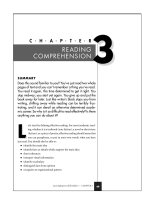5261 flowers reading comprehension
Bạn đang xem bản rút gọn của tài liệu. Xem và tải ngay bản đầy đủ của tài liệu tại đây (76.65 KB, 1 trang )
Name: .......................................................... Class:
....................
Date:
........ /....... /.......
True or false? Tick the correct column.
Daisies are very popular flowers.
They are very decorative.
The flower and the plant have the
same name. They have a yellow disc
floret surrounded by long thin white
petals.
Daisies are herbaceous plants
what can reach between forty and sixty
cm high
They blossom from Spring until
the beginning of Winter.
Daisies grow wild in the field but
we can find them in flowerpots and
window boxes.
In ancient Rome, the surgeons who
accompanied Roman legions into battle
ordered their slaves to pick sacks full of
daisies in order to extract their juice.
TFDaisies have a central white disc floretIt is a very
popular flower which grows in parks, fields and
balconies.
Their petals are long, white and thin
They only blossom in Winter
The plant and the flower didn’t have the same
name
Romans didn’t know these flowers
True or false? Tick the correct column.
Rose is considered the “queen”
of the flowers and it is the most sold
flower in the florist’s .
The plant is called rosebush, the
flower is the rose and the fruit is a fleshy
berry which contains many small seeds.
They blossom all over the year.
There is a wide variety of them.
Roses do not only vary their colour, they
can have a different number of petals
and even you can find big, medium, small
o very tiny roses.
From them we can get oils for
perfumery or medicinal and gastronomic
uses. Romans already knew these
flowers : they have blossomed since
Stone Age
TFRose is known as the “ princess ”
of the flowers
They are the most sold flowers.
Rose is the real name of the plant
They only blossom in Summer
All the roses have the same size
Romans didn’t know these flowers









